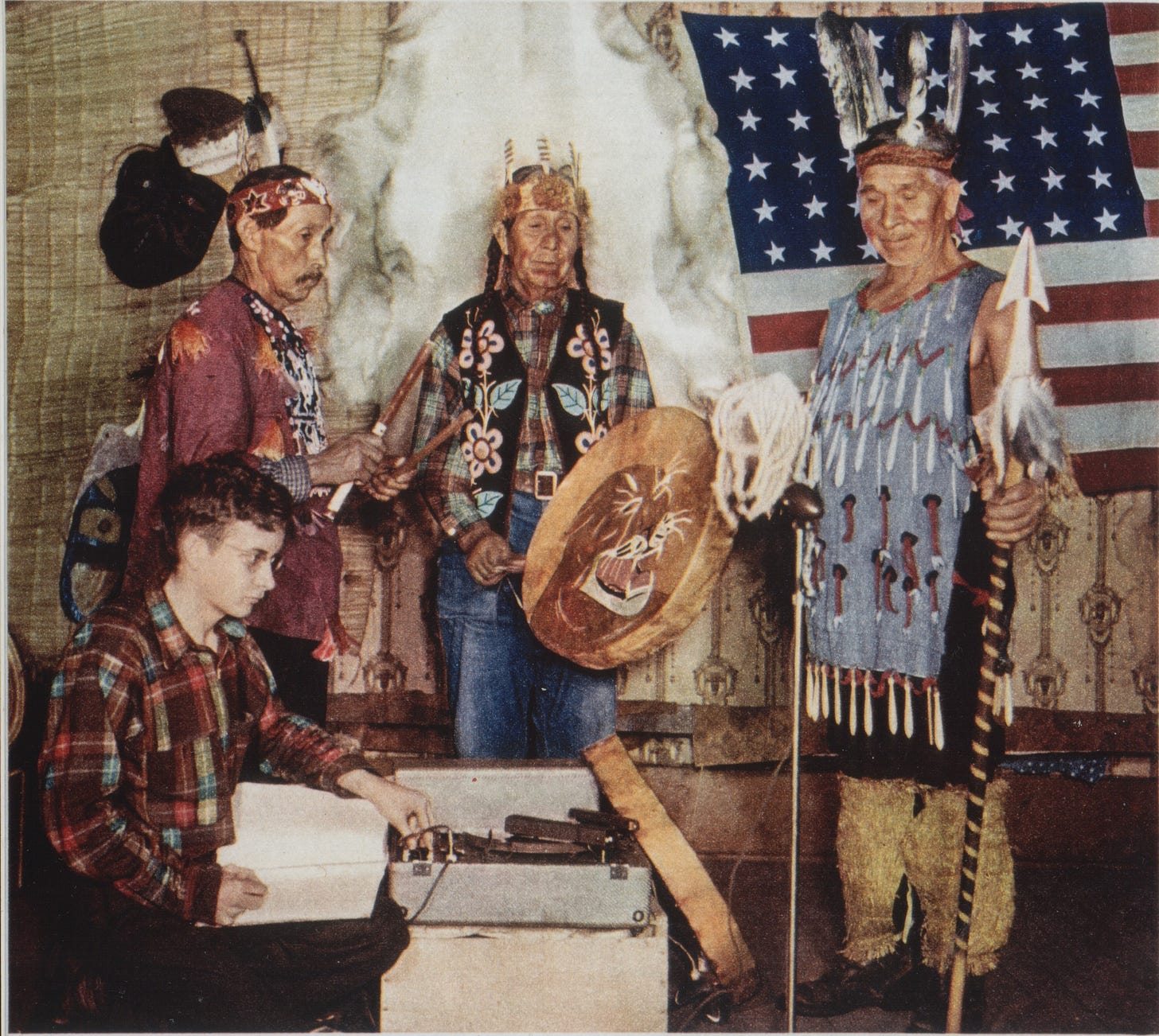Harry Smith at Juvenile Music Club in 1943
Indians of Washington state and British Columbia being his particular interest
A few months after Harry Smith and his mother presented on Northwest Indians for the Anacortes Women’s Club, he staged a solo show in Bellingham for its Juvenile Music Club, which was reported in the Bellingham Herald of 28 February 1943. We learn from Harry’s early gigs – and the regional and national publicity he attained – that he wanted to share what he was recording with his communities, and that he was recognized for his authority and the significance of his work.

SPECIAL PROGRAMS FOR JUVENILE MUSIC CLUB
Harry Smith, youthful authority on Indian music whose picture and article about his work appear in the current issue of The American Magazine, will be the speaker and will play his own recordings of Indian music at the Juvenile Music club meeting Wednesday afternoon. The club will meet at 4 o’clock at the Hotel Leopold.
Miss Elena Bateman and Mrs. Rogan Jones will be in charge and announce that children who have Indian curios and want to bring them may do so, a display to be arranged.
Harry is the son of Mr. and Mrs. Robert Smith, of this city, and has made a special study of Indian music for several years, the Indians of Washington state and British Columbia being his particular interest.
The history of the Juvenile Music Club in Bellingham is also worth tracking as an example of creative community infrastructure. News accounts of a Mozart event and an Indian music program from the early 1920s note that the juvenile club was sponsored by the Women’s Music Club. The youth programming had a broad focus and endured through the 1950s, meeting throughout the year and even hosting the state meet of youth music clubs in 1930 at which visiting groups – like the Anacortes Junior Choir – performed. In 1942 the juveniles participated in a “folk song” event and other programs in 1943 were on “American music” and “the music of our allies.”
What was meant by folk music in Bellingham in the first half of the 20th century? At a previous folk song program of the club in 1936, the story of “Comin’ Thro’ the Rye” was related. The Bellingham Herald ran news of “folk song” events that included “Irish ballads” in 1904, stirring Scotch folk songs in 1906, and in 1908 “colored folk songs.” In 1911, the paper reported on a Normal college commencement pageant entitled “The Spirit of the West” in which “spectacular events drawn from the history of the Pacific Northwest will be depicted and the folk songs, dances and the national customs of all the nations congregated in this section will be united into one evening’s entertainment.”
Sadly, this international inclusiveness did not always extend to Native American music, as the Herald trolled in 1913: “Uncle Sam is planning to record native Indian music for use in the government’s Indian schools. It would be the part of cruelty to foist some of it upon the white man.” In the decades that followed, the paper ran accounts of white academic interpretations of Indian music and occasionally news of actual Coast Salish performances, events like the Garden Street Methodist Episcopal Church hosting Rev. Joseph Hillaire and “other Indian young people visitors and pipe organ and solo Indian music.” In 1944, the year after Harry Smith’s presentation of his Coast Salish recordings at the Juvenile Music Club, the Herald noted that “two hundred recordings of Indian music will be preserved in the Library of Congress in Washington.” In the 50s, local Indian music events on and off reservations made news, like the “All-Indian Music Program” at the YWCA in 1957.
In Sounding for Harry Smith: Early Pacific Northwest Influences I try to trace the roots of Harry’s life of achievement that led to a Grammy Award for creating the Anthology of American Folk Music:
This book follows a version of Harry Smith who digs for the understanding way. He learns from, records, and amplifies the voices of others, an advocate for unique beauties. Among Harry’s varied brilliances, it was his ability to listen and see and value and act in concert with the preservation of cultural treasures—those that surface forces had lost, or tried to break and bury. In the mountains of scrapped 78 rpm records, Harry heard the patterns of disparate compositions as a choir compiled to sing a new American folk into existence.
Harry’s many accomplishments in music, art, and culture were rooted in the influences of his Coast Salish studies and experiences, where he learned about presence and resilience. In Sound Salish Straits, author Jay Miller writes that “when the late Martin Sampson, a Swinomish leader, was asked by Vi Hilbert, a Skagit relative, to define Native culture, he said it was ‘learning from the land.’”
Harry’s upbringing in the Pacific Northwest had enduring importance in his life and work. “Whatever affliction Harry may have been to himself and his community, a more powerful part of Harry continued to engage and invest in his culture, in ways that extended everywhere—magically.”

